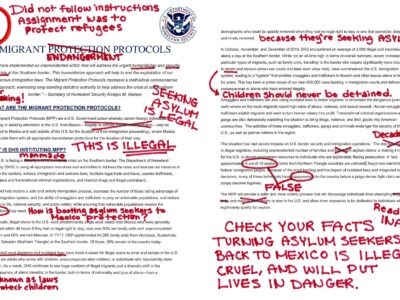Detaining People Seeking Protection: Inhumane, Unnecessary, and Wasteful
Jailing people seeking asylum protection in U.S. immigration detention centers is a cruel and costly mistake.
- Detention inflicts enormous physical and psychological harm, exacerbates trauma for individuals fleeing persecution and torture, blocks access to legal representation, and often makes it more difficult for asylum seekers to fairly present claims for protection.
- Medical studies have repeatedly confirmed that immigration detention is dangerous to the health of detainees. The COVID-19 pandemic made the horrors of detention all the more apparent: the government’s failure to release many immigrants from immigration detention centers led to widespread disease transmission, death, and serious illness.
- In addition to inflicting harm, immigration detention is costly and unnecessary. The Department of Homeland Security (DHS) is not required under U.S. law to detain asylum seekers and has existing legal authority to release people to communities where they can safely live with family and friends to wait for their cases to be decided.
- Detention of asylum seekers flouts U.S. legal obligations under the Refugee Convention and Protocol. In its guidelines on the use of detention, the U.N. Refugee agency (UNHCR) has confirmed the general principle that “asylum-seekers should not be detained” and that “the use of detention is, in many instances, contrary to the norms and principles of international law.”
People seeking protection at the border can be released pending adjudication of their cases
DHS has existing legal authority to place asylum seekers who request protection at the United States border whether at or between ports of entry into regular removal proceedings and to release these families and individuals to wait for court proceedings in the community, rather than subject them to detention and expedited removal—an extremely flawed process that risks returning refugees to persecution and torture. They can be released on parole – a legal mechanism through which DHS can process an individual into the United States for humanitarian reasons or significant public benefit to avoid the use of detention. In addition, asylum seekers who have been subjected to expedited removal and received a positive credible fear determination can also be released from custody on parole under the 2009 DHS Parole Directive, if they establish their identity and demonstrate they are not a flight or security risk.
While DHS has discretion to set additional conditions when granting parole, given that the overwhelming majority of asylum seekers appear for their immigration hearings, the agency should avoid the imposition of cruel and unnecessary restrictive monitoring conditions, such as the use of ankle shackles. Ankle shackles inflict enormous physical and psychological harm, result in social isolation and employment discrimination, are disproportionately used against Black immigrants, and, like detention, are unnecessary and ineffective.
Detention of asylum seekers is unnecessary to ensure appearance at court hearings and wastes government resources
Studies have repeatedly confirmed that asylum seekers overwhelmingly appear for hearings after they are released from DHS custody, rendering the use of costly immigration detention unnecessary to ensure future appearance. Appearance rates are even higher where asylum seekers are represented by counsel. For example, 96 percent of non-detained immigrants represented by a lawyer attended all of their hearings from 2008 to 2018.
In addition to being unnecessary, detention is fiscally wasteful. Community-based case management alternatives are far less costly, as well as more humane and effective. For instance, a family case management program piloted by DHS from January 2016 to June 2017 demonstrated high levels of success, including a 99 percent appearance rate for hearings. This program cost about $36 a day per family while family detention costs almost $320 a day per person in family detention centers.
____________________________
[1] The administration can refer asylum seekers for full asylum interviews with U.S. Citizenship and Immigration Services asylum officers in their destination locations, ramping up asylum office staffing to fully adjudicate asylum requests, which will result in quicker initial decisions and reduce the number of individuals ultimately referred to immigration court hearings. These full asylum office adjudications should not be conducted within the expedited removal process, which would limit due process.

